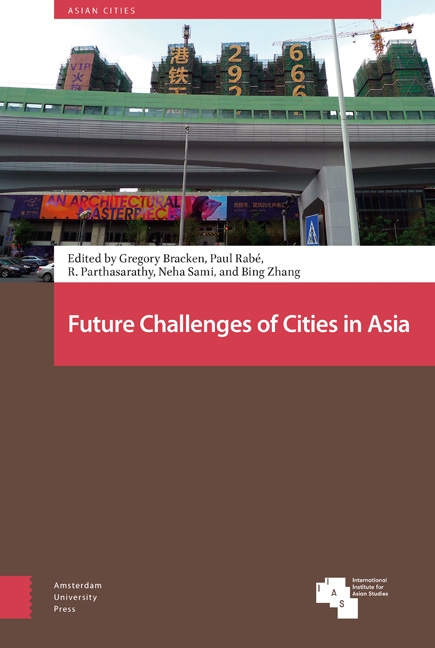Book contents
- Frontmatter
- About the Three UKNA Volumes
- Contents
- List of Figures and Tables
- 1 Future Challenges of Cities in Asia: An Introduction
- 2 Human Agency in the Asian City
- 3 Toward Inclusive, Vital and Livable City Scenarios: The Transformation of Urban Villages in Shenzhen
- 4 Cultural Dilemma in Beijing's Urban Regeneration: From Liulichang Cultural Street to Qianmen Street and Yangmeizhu Oblique Street
- 5 Housing as Heritage: The Great Urban Dilemma of the Global City of Shanghai
- 6 Not an Act of God: Lessons from a Disaster in the Settlements Planning of a River City
- 7 The Political Ecology of Climate Injustice in Bangkok
- 8 Assessing Flood-Related Vulnerability of the Urban Poor
- 9 The Ecological Future of Cities: Evaluating the Role of Green Infrastructure in Promoting Sustainability/Resilience in India
- 10 Hong Kong's “Rail-plus-Property” Development: A Model for Financing Public Transportation in Developing Cities in Southeast Asia?
- 11 Large Infrastructure Projects: The Emergence of Corridors in Asia
- Index
- Publications / Asian Cities
3 - Toward Inclusive, Vital and Livable City Scenarios: The Transformation of Urban Villages in Shenzhen
Published online by Cambridge University Press: 21 November 2020
- Frontmatter
- About the Three UKNA Volumes
- Contents
- List of Figures and Tables
- 1 Future Challenges of Cities in Asia: An Introduction
- 2 Human Agency in the Asian City
- 3 Toward Inclusive, Vital and Livable City Scenarios: The Transformation of Urban Villages in Shenzhen
- 4 Cultural Dilemma in Beijing's Urban Regeneration: From Liulichang Cultural Street to Qianmen Street and Yangmeizhu Oblique Street
- 5 Housing as Heritage: The Great Urban Dilemma of the Global City of Shanghai
- 6 Not an Act of God: Lessons from a Disaster in the Settlements Planning of a River City
- 7 The Political Ecology of Climate Injustice in Bangkok
- 8 Assessing Flood-Related Vulnerability of the Urban Poor
- 9 The Ecological Future of Cities: Evaluating the Role of Green Infrastructure in Promoting Sustainability/Resilience in India
- 10 Hong Kong's “Rail-plus-Property” Development: A Model for Financing Public Transportation in Developing Cities in Southeast Asia?
- 11 Large Infrastructure Projects: The Emergence of Corridors in Asia
- Index
- Publications / Asian Cities
Summary
Abstract
Currently Shenzhen is experiencing industrial upgrading and city reprofiling, transforming from a world factory to a world city. It is a crucial moment to rethink the future of urban villages in the city, informal settlements that emerged extensively along with rapid industrialization and urban development in the past three decades, and played essential roles as “arrival cities” for migrants. This chapter investigates the formation process of urban villages as well as planning strategies for future development, from the perspective of urban form and governance. Urban vitality, livability, and inclusiveness are addressed as multidimensional urban values that could generate common interests among stakeholders, which therefore could be considered desirable and possible future scenarios for such neighborhoods in Shenzhen.
Keywords: migration, urban regeneration, livability, urban vitality, inclusive development
Introduction
The development of Shenzhen started in the late 1970s. It was the first special economic zone in China, a “lab” of economic reform and the opening-up of the country to foreign investment. A rapid process of industrialization started ever since, and it became a “world factory” attracting foreign investments for export-oriented labor-intensive manufactory industries, which led to a huge influx of migrants. After more than three decades of development, the city grew from a town of 300,000 people to a big metropolis with a population of more than 10 million. Nowadays Shenzhen is very often mentioned as a city of migrants, with a floating population of 7.46 million, according to statistics from 2014. Although this number is not as high as Beijing (8.03 million floating population in 2013) and Shanghai (9.96 million floating population in 2014), the proportion of migrants in Shenzhen (69.2% of the total population in 2014) is much higher than in Beijing (38% of the total population in 2013) and in Shanghai (41% of the total population in 2014). These numbers imply challenges for the future urban development of Shenzhen in the context of migration, namely, accommodating newcomers and integrating them in the city socially and spatially.
In the past three decades, urban villages have contributed greatly in meeting such challenges. This is a special type of informal settlement, which emerged during the rapid industrialization and urbanization processes in Shenzhen, also seen in other cities in the Pearl River Delta (such as Guangzhou).
- Type
- Chapter
- Information
- Future Challenges of Cities in Asia , pp. 39 - 64Publisher: Amsterdam University PressPrint publication year: 2019



